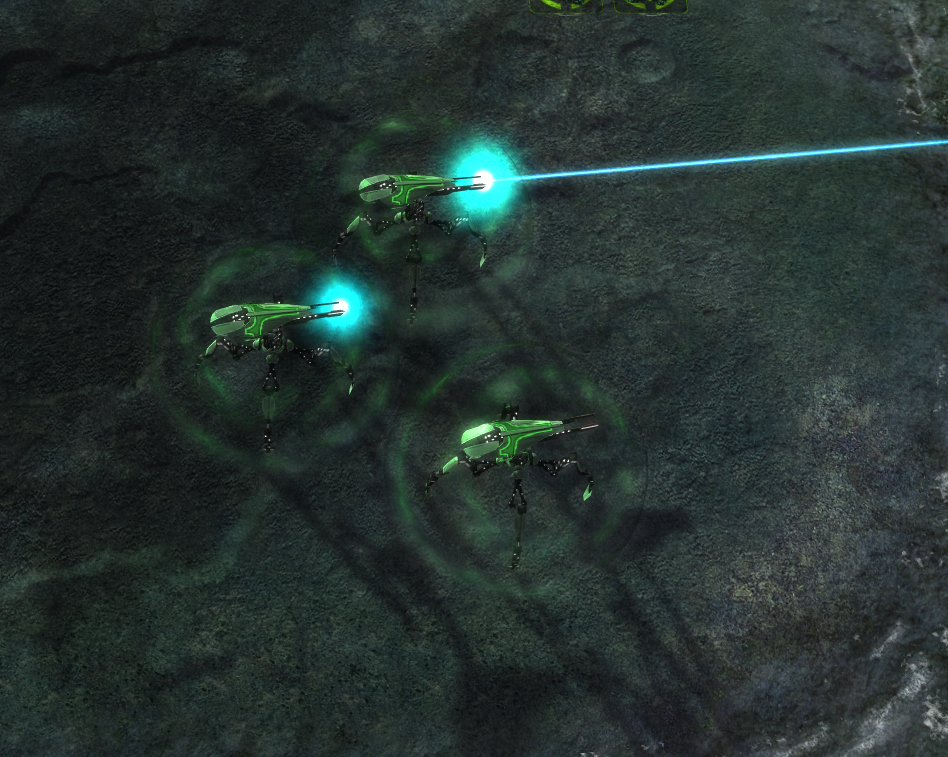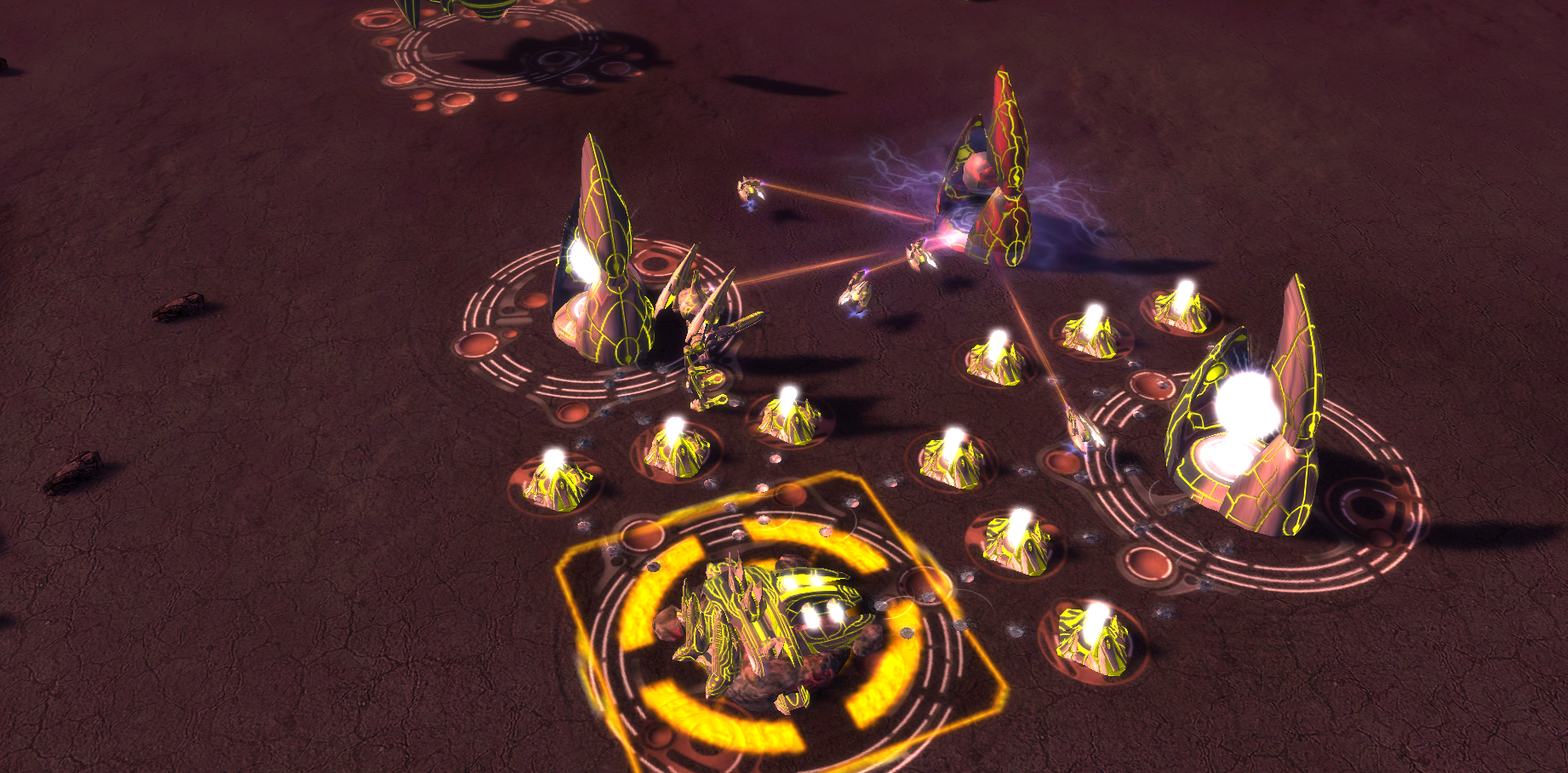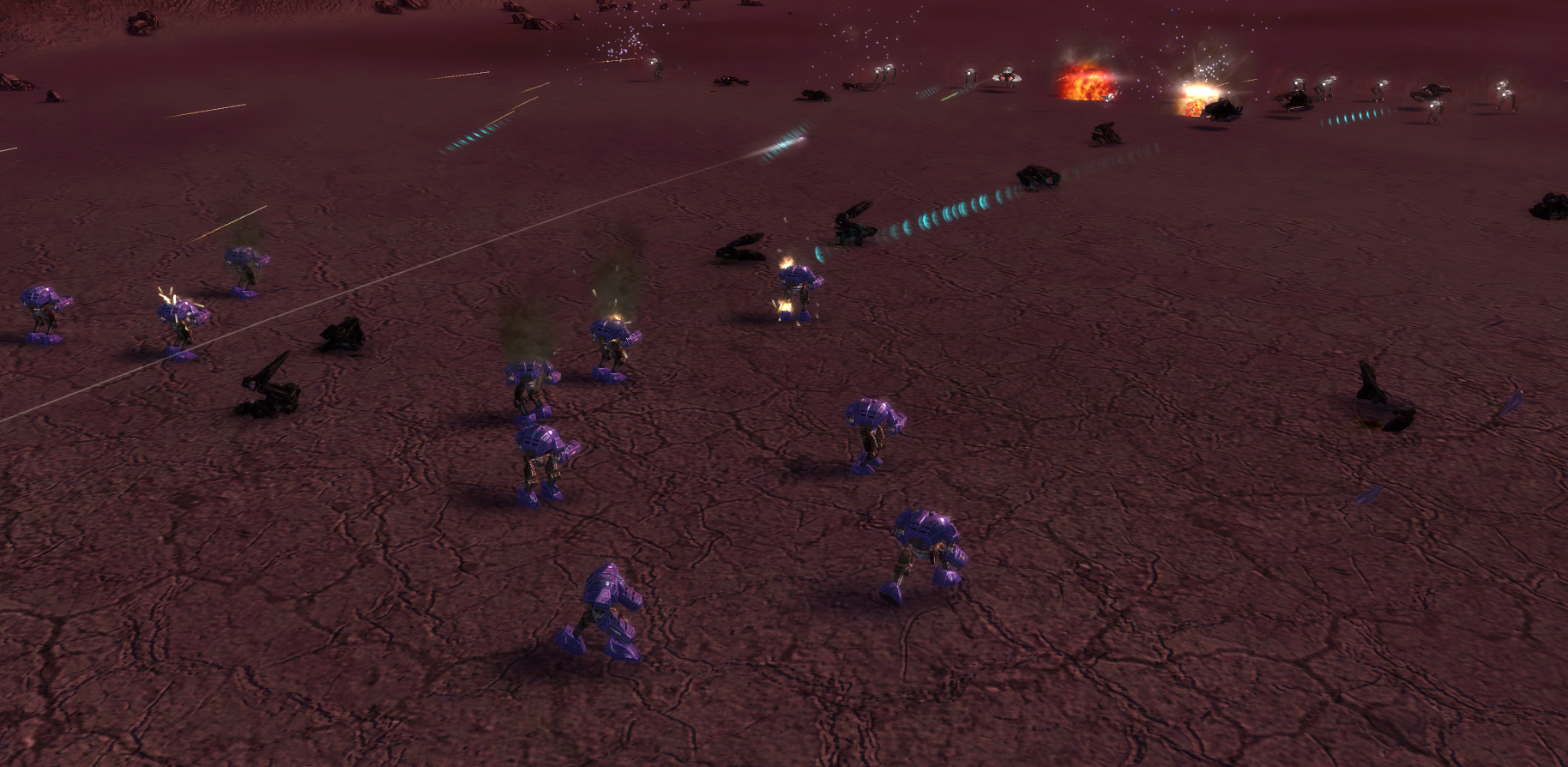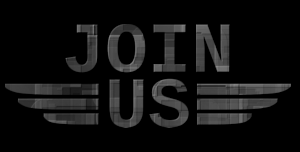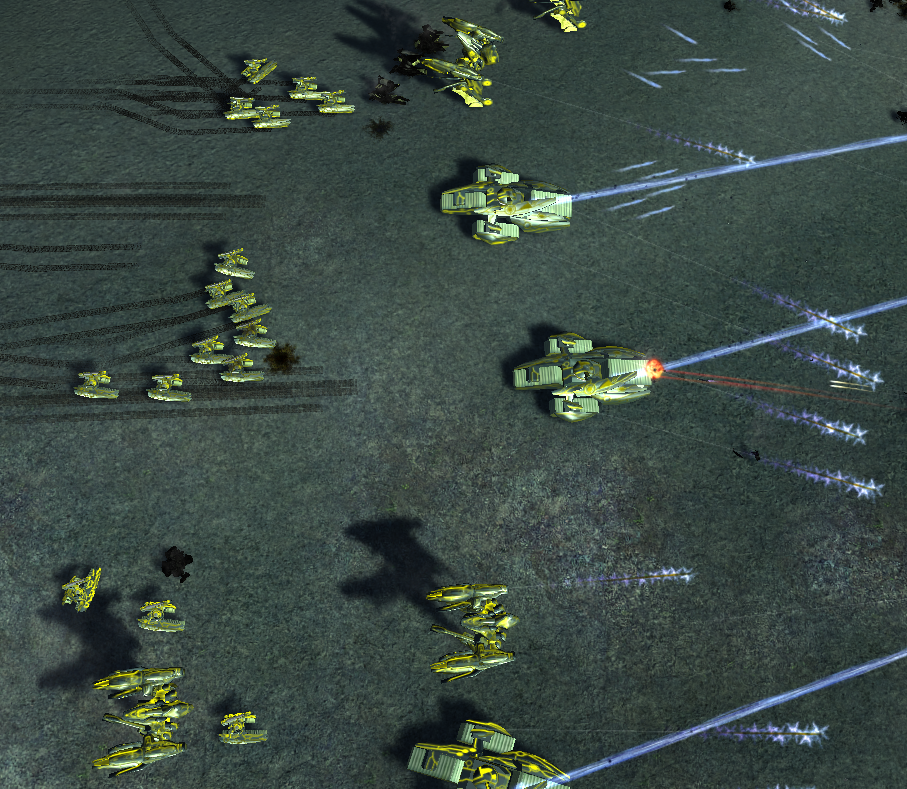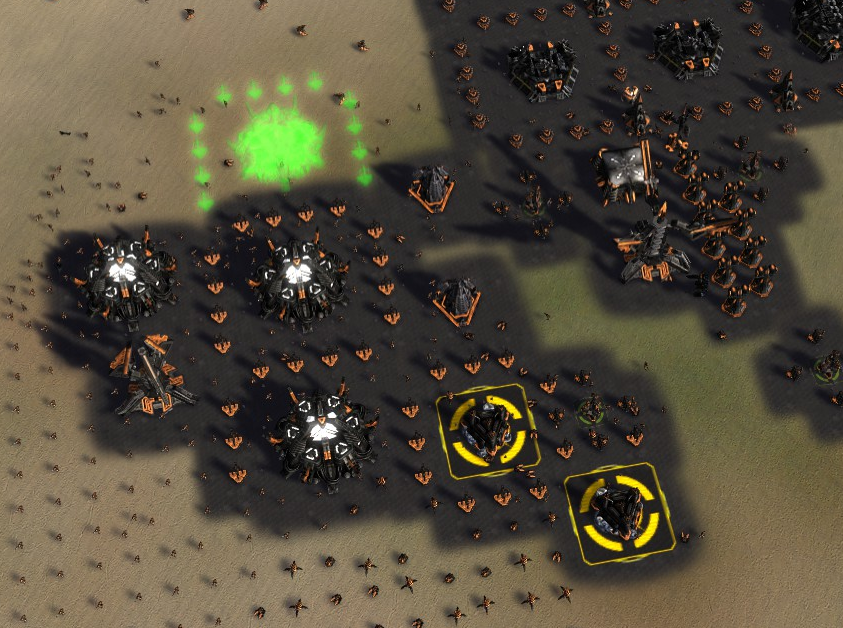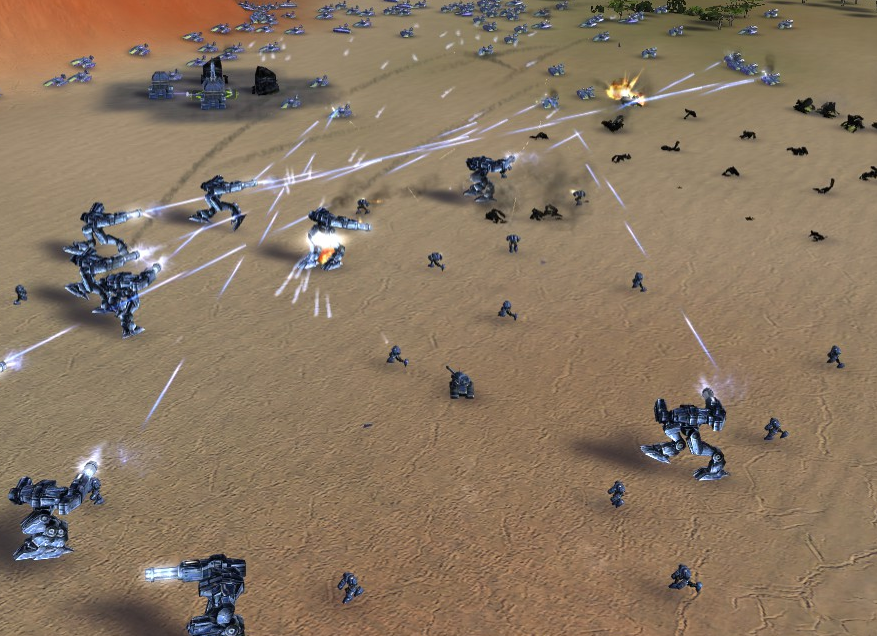I decided to re-design SupCom/FA/F’s core balance and game mechanics in order to help cope with some stuff I've got going on.
It was a lot of work, but a lot of fun. I hope this provides FA(F) players with sort of a gameplay “side B”; if you like the SupCom “grand strategy” design but don’t prefer the balance, then maybe this will be a different experience. The game play is generally slower and more akin to an RT4X game such as Sins of a Solar empire.
The mod is titled Wars of Glory (1.0). Find it in the mod vault!
To start, see this beginner's guide video.
EDIT: If you want to use the AI, you (sort of) can! Set Sorian AIX to a resource bonus of 5 and a build rate of 1. It should build play a somewhat decent T1 game.
See the alpha showcase video here (same as the one of the mods forum) for some more info on gameplay.
Also see the alpha thread here.
While the mod is complex and has a lot of moving parts, it can be boiled down as follows:
-
First of all, the game as whole feels different. Like, really different. The Striker has a range of 36 and a DPS of 2, ASFs are Tier 1 and countered by T1AA and air experimentals, T1 subs have 7000hp, the Ilshavoh costs 900 mass is the size of an ACU, the Othuum fires a laser, T2 tactical missiles have the range of T3 arty, T1 power generators have unique adjacency bonuses that make them absolutely integral to every base at every tier, the Rhino is basically a artillery piece, infantry [light assault bots] regenerate their health in 30 seconds, and T1 mexes should be capped with mass storage before building new ones.
This being said, some things are similar (naval, gunships, and MMLs come to mind). Still, forget (almost) everything you know about SupCom balance.
-
Unit damage and speed has generally been reduced; however, no land unit has a speed slower than about 1.4 (in my play testing, units slower than this I found to be too slow to be fun to use). As a result of this, unit groups only differ in speed by maybe 0.5, making ranks etc cohesive without the use of formations. Range has generally also increased. As a result, battles take more time to resolve and generally revolve around cohesive ranks of units.
As a result of the, battles and maps become more dense. A 10x10 map plays more like a 20x20, and on larger maps most of the space isn’t even used. Since effectively units live longer, a lot of new tactics come out of the woodwork which might have not been there before.
-
Land balance is based on infantry (light assault bots) as we as varying forms of fire support. Direct fire support (EG T1 tanks) fire a low arc projectile, whereas indirect fire support (EG Medusa/Fobo) fire a high arc projectile. Both are designed for infantry support.
-
Air balance is based on a ground attack/anti-ground attack/fighter model. Inties counter bombers/gunships/heavy stuff; ASFs, which are now T1, counter inties; T1 ground fire—but not T2/3 mind you—counters ASFs. T3AA counters air experimentals/stratbombers.
-
Naval balance has probably been changed the least. T1 ships are more powerful and closer to T2, and sub balance revamped almost completely.
-
T4/Experimental balance has been changed, but very surgically. Experimentals basically cost the same, but are slower, because almost everything is slower. The T4/counter mechanic tries to follow the nuke/anti-nuke mechanic, where scouting and pre-emptive counters for specific experimentals is required.
-
The economy system is based on holding onto and developing existing mass points instead of taking new ones. Mex upgrades are cheaper, but take more time to build. In total, it might take you 5-10 minutes to build your base and forge and army. A chunk of your initial time will be spent building mexes and capping them at T1 before you expand; raiding is more of a mid- to late-game phenomeon!
-
Tier advancement is integrated into the commander engineering upgrade. T1 engineers are the only engineers (unless you’re Aeon, but that’s another story), and can build all three tiers when the commander is upgraded.
-
I’ve changed or added a handful of new effects. For example, many of the cybran “pew pew” lasers are now yellow plasma cannons, and the harbinger’s glitterbomb weapon is now an actual laser.
This mod has been made more or less “for fun” and is not meant to replace or fix FAF (I’m a 200 level player). Many of the balance mechanics predate FAF, FA, or even the original SupCom, and are rooted in gameplay concepts I’ve had in my head since the original 2006-era interviews/media/etc. I’ve taken balance concepts from games such as Command and Conquer, the original Total Annililation, and St**cr*ft (a swear word on these forums, but as a game it’s good at what it does).
Balance notes on units/etc.
Technology, tiering, and the ACU.
Tiering is very, very different than in FA(F). Tiering is integrated into the ACU; that is, upgrading your ACU’s engineering suite to T2/3 permits engis and strategic factories to build higher tiers of units. Higher tier units are balanced accordingly; they are NOT meant to be heavy T1 killers, but rather powerful and specialized support units!
Since an entire arm of the ACUs’ upgrade suite is dedicated to tiering upgrades, subsequent upgrades have been moved to the back and/or other arms. Choose wisely!
There are two types of factories and one type of engineer, apart from the Sparky and Aeon naughtiness. “Normal” factories are relatively small and build T1 units; “Strategic” factories are much larger and more expensive-they can build T1-3 units. T1 engineers can build all three tiers, and thus T2/3 engis have been removed. However, at T1, only T1 units can be constructed.
Engineering stations and associated stuff. While only T1 engineers and the SCU/ACU can build bases, UEF and Cybran still have engineering stations. Since factories can’t be efficiently assisted, these instead augment construction projects and had have a much expanded build radius.
Aeon/Seraphim don’t get engi stations (obviously); instead:
• Aeon gets all three tiers of engis, each one with a higher build rate and a balanced cost. The idea is you can upgrade your engis and sacrifice the old ones. Note that T2 engis can still build T3 with the commander upgrade, however—there still is no “replacing” engineers to build higher tiers.
• Seraphim only get T1 engis and no engineering stations, but the engi build rate increases 50% with each commander upgrade.
ACU upgrading costs energy and time-but the infrastructure investment is substantial (and bombable). Basically, upgrading the ACU takes a solid chunk of energy for a solid bit of time-sort of like the Overcharge, but for everything. A chunk of your base must be dedicated to ACU upgrades, since this is how you advance to higher tiers.
Notes on tier rushing. You can probably get to T2-3 relatively quickly (for WoG, that means within an hour). However, you’ll run into several problems if you try to rush too quickly:
-
Higher tier units require strategic factories to produce. These cost a chunk (around 3600 mass). You’ll need to build one or more of these to actually build higher tier units.
-
Defensive structures such as shields are expensive and draw a lot of power (but are strong and big). Again, you’ll need to invest heavily to build them, even if you can build T2.
-
Many T2 units aren’t that much stronger than the T2 counterparts-this is especially true for air, where fighter/bombers are fast tactical assets rather than ACU/base-clearing death machines.
Economy, tiering, and production guide.
*****Note that all energy values are 10% of FA(F). For example, a 500e generator now produces 50e. Everything is scaled accordingly. This is because energy costs of some things get so large that you end up putting numbers like 1200000000 in the interface, which looks silly.
The ACU. The ACU is a little different here. While the primary gun has been nerfed (along with basically all the other land units), the overcharge has not, and stuff like gun upgrades is much easier to purchase due to the lower mass cost.
Is the combat commander a thing? Yes...with lots of backup. But the tiering requirements and high build rate throw a monkeywrench into the equation.
• The ACU’s engineering suite controls the tier...and that’s it. Upgrade your ACU, and all your “T1” engineers can build T2 or T3 buildings, as can your strategic factories (but not standard factories; see below). Since these upgrades can take a while, the ACU must be defend for an extended period while it upgrades.
• The ACU has a build rate of 20; this is 10x that of a UEF/Cybran engi and 5x that of an Aeon/Seraph engi.
• Since the ACU engineering suite is required for game progression, other upgrades which are on the same arm (IE, gun upgrades) have been moved to other slots. This means that the ACU receives some degree of nerf with regards to other upgrades; however, the upgrades re also less expensive and mostly require energy.
You can the overcharge, you upgrade you commander, you can teleport—but you’re going to need quite a few energy storages to do any of them. ACU upgrades are less about your total resource input and more about the state of your logistical grid (do you have energy and energy storage? It it well protected? Can your commander stay in one place enough to survive to complete the upgrade?).
Factories. Factories are expensive strategic assets which cannot be easily assisted by engineers and cannot be upgraded in the traditional sense. They also have a base power draw in addition to the draw of the unit. However, some units are dedicated to adjacency bonuses; these include Auxiliary Generators (auxgens, formerly T1 gens) which substantially reduce or eliminate this power draw, as well as Fabricators (fabs, formerly mass fabs) which increase the build rate of factories in the place of engineers, as well as reduce the mass draw of unit production.
A substantial portion of the early game can be dedicated to “augmenting” or upgrading a factory with pgens and fabs to remove the large power draw and increase factory build rates through the adjacency bonus. Subsequently, an factory (or even an economy) can be crippled by destroying adjacent structures without destroying the factory itself!
There are two types of factories:
• Primary or standard factories only build T1-but they are relatively inexpensive cost effective. Note that T1 is much more ubiquitious here than in vanilla FA(F), so this isn’t as nerfed as it might seem.
• Strategic factories build all 3 tiers and have a higher build rate. They respond to the ACU’s engineering suite upgrade by being able to build units at that tier.
Primary(T1)/strategic(T3) generators. Primary generators (pgens/primgens, formerly T2 generators) are now T1 and cost quite a bit-but you’ll be needing to build them early game. Mexes take a lot of juice, unit production takes a lot of juice, upgrading mexes takes a lot of juice, and tiering up to T2 and T3 takes energy almost exclusively. In WoG, where as mass might be the production resource, energy is the logistical resource. T3 strategic generators (stratgens) are basically primgens-but really, really pricy and powerful.
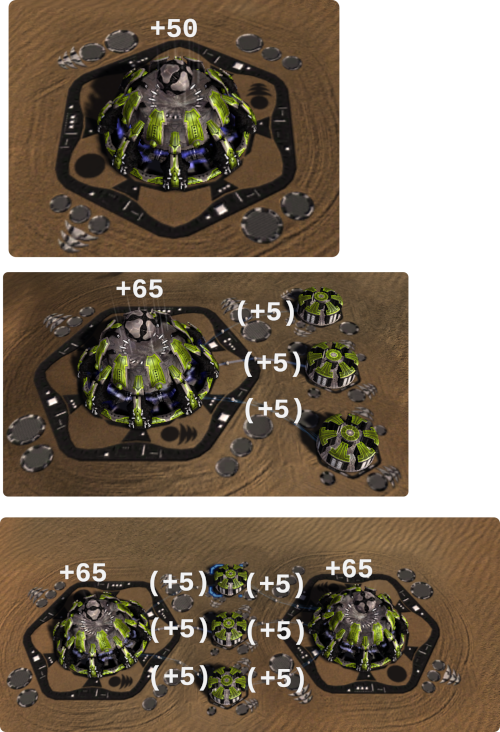
Auxiliary generators (auxgens). These reduce energy draw substantially (25-50%, depending on the type)-but the effect does not stack with multiple adjacent generators. What this means is you should build a single adjacent generator to your structure of interest; building more won’t help you!
Note also that auxgens are the only power generators which can give factories and energy consuming structures adjacency bonuses. T1 and T3 primary generators can only use energy storage adjacency bonuses!
Hydrocarbon primary generators. These produce the same energy as a primary generator….but are 40% cheaper and have more armor. Same adjacency bonuses otherwise.
Mexes. T1 mexes draw 15e, equivalent to about 1/3 of a primary generator, produce 50% more mass, are expensive, and have a lot of armor. T2 and T3 mexes draw even more power. Higher tier mexes have not a lot more mass cost than T1, but have massive energy costs and build times. Note that there’s a little bit of lore behind this: the idea is that upgrading a mex involves simply drilling deeper into the mass deposit, and the player that spends the most time mining their mass deposits gets the greatest benefit. T3 mexes cost about 1000 mass-and have extremely long build times, making them very valuable.
Note that capping mexes with storage increases the mass output by 100%-in the case of T1, it’s +6 mass instead of +3. Given the massive power draw, this is actually a good deal-it’s to your advantage to ring your core mexes before going out and looking for new ones. The goal, ultimately, is the reduce the “hockeystick” effect reinvesting mass to get more mass and make the economy more about defending what you have well for a long period of time. As a result, the economy game can feel somewhat less stressful than FAF. You can cap your T1 mexes with shift+right click like T2 and T3.
Mass purifiers. Formerly the T3 mass fabricators, these convert energy into mass. Sort of. These have a special adjacency bonus which increases when adjacent to a mex. A mass purifier adjacent to a T1 mex might produce 6 mass, whereas it would produce 12 mass when adjacent to a T3 mex. They can be considered a sort of “mass storage mark II,” though they draw TONS of energy and make for a juicy stratbomber target.
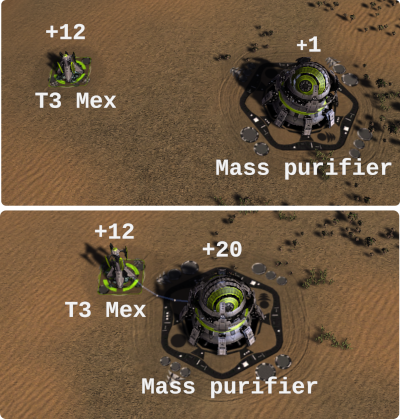
While you can’t fabricate mass in WoG, you can still make quite a bit of it from your core mexes. One T3 core mex will produce 12 mass (not 18, like in FAF!), but with four adjacent mass purifiers it would effectively produce 80. That’s pretty intense.
Land unit guide. Land balance uses a combination of infantry (light assault bots) for LOS and direct fire, direct fire support for hitting things outside of LOS (think the FAF mongoose, but the role fleshed out more for every faction), higher tier direct fire units for close-up force multiplication, and indirect fire support/artillery for base assault.
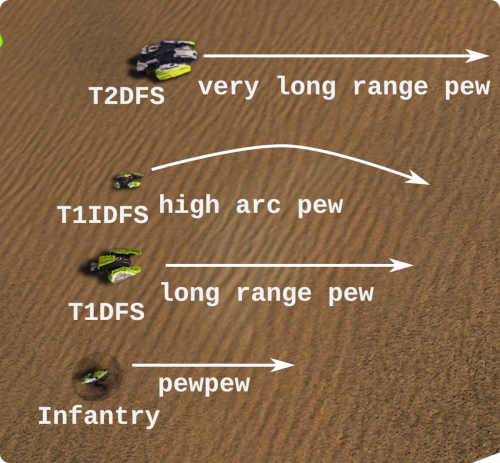
T1 are the “bread and butter” units.
T2 is support, mostly. T2 direct fire units have shorter range and higher damage and back up infantry/short range T1, whereas T2 (in)direct fire support have long ranges. Really long ranges.
T3 “siege support” is a combination of direct and indirect fire which is designed to be a strategic asset to breaking bases and defensive lines.
Basically, build a lot of infantry and fire support. To some extent, everything else is either a specialized unit or a gimmick.
Infantry (mech marine/hunter/flare/selen), far from being disposable raiding units, are integral to the game due to their high mobility, high damage, and low cost (15-20 mass). Unique to land units, they have very high health regeneration rates, and can regenerate completely in less than a minute—this makes them very resilient, even into higher tiers. All land units have been balanced with infantry in mind, and they are core to the gameplay of WoS.
The mech marine and hunter are roughly equivalent, with the MM slightly stronger-but the hunter can be backed up easily by mantis’ which are about the same speed.
The flare is the strongest and most expensive combat infantry, with a nearly 100hp personal shield. While the shield draws an infinitesimal amount of energy, an energy stall will still cause it to turn off!
The selen has low health and cost and higher regen than other infantry. While it can’t compete in direct combat, it’s cloaking ability is crucial for seraphim, to provide intel to fire support units.
Tier 1 direct fire support (T1DFS; striker/mantis/aurora/thaam) provide lower, direct fire damage with a slow refire rate over a very long range and are generally balanced as general purpose infantry support units; while infantry provide LOS, T1DFS multiply the effective combat power of the army or platoon.
The striker is a very capable unit useful for both offense and defense when provided with sufficient LOS or radar coverage.
The mantis has a shorter range than other factions, but moves and fires faster, thus providing the cybran commander with a very capable unit.
The aurora is slow, poorly armored, and doesn’t have the range advantage of FA(F). It’s weapon damage has been buffed to compensate for this and it is very nasty.
The thaam is fast and powerful, with the slight cost buff versus other T1DFS similar to the zthuee. As seraphim lacks a direct combat infantry, this unit as the sole responsibility of both offense and defense for seraphim. Provide LOS using selens.
T1 indirect fire support (T1IDFS; lobo/medusa/ferver/zuthee). These units fire an arcing projectile similar to FA(F), but have much longer ranges and very slow fire rates to deal with clusters of slower units as well as base defenses. Due to the high HP of buildings in WoS, these are probably the only units which are dangerous to bases themselves at T1.
T2 direct fire (T2DF; mongoose/riptide/blaze/ilshavoh). These are fast-firing units with a range in between infantry and T1DFS; these are likely the strongest land anti-infantry units for their cost. The simularities end there. Note that the UEF gets two direct fire T2 units, cybran gets none, and aeon/seraphim get one.
The mongoose is a good, if pricy, all-around unit against groups of smaller units and is likely the closest to T2 infantry. Only UEF really gets a T2DF unit at this price point.
The riptide is a weaker mongoose-ish unit with more armor which can hover. Good for fast attacks or ambushes.
The blaze does a ridiculous amount of damage for its size and cost, but has paper thin armor similar to the aurora and thus is heavily dependent on mobile shields and vary forms of fire support.
The ilshavoh is a 900 mass monster comparable to many T3 units in strength. While it can turn the tide of battle, the commander must be careful with this unit, as it can quickly become a target and can be hit by a variety of FS units. Seraphim is especially dependent on these units throughout the game (or after T2), since they don’t get another strong, short-range unit until T3.
T2 direct fire support (T2DFS; pillar/zethus/hoplite/yenzyne). These are very long ranged units with a flat firing trajectory and higher damage than T1DFS, but with slower refire rates, projectile velocities, and higher cost. These are important units to start T2 with, but they must be properly supported.
Note that cybran get 3 of these; everybody else gets one.
The pillar is sort of all-around good, with a fire rate only moderately slower than the striker.
The zethus [formerly rhino; I hate that name] fires very quickly for a T2DFS unit and is very dangerous. This is absolutely crucial for cybran at T2, as they lack a solid T2DF at this tier.
The hoplite is a T2DFS unit, but in contrast to the zethus is very fast and has high splash damage. This unit should be utilized alongside the Mantis; cybran effectively has two categories: slow, head on units and fast flanking units.
The wager is massive, heavy zethus with a slower firing cycle which can hide underwater. While slow and pricy, its durability makes it difficult to work against, even for naval units.
The obsidian, like the aurora, has a very strong cannon which fires extremely slowly. Unlike the aurora, however, it has a thick shield and is durable. This unit is best against larger, slower targets and becomes virtually useless against lighter units.
The yenzyne is not particularly different from the slower firing T2DFS units-except it can hover, meaning it can fight naval vessels. It also outranges many of them.
T2 indirect direct fire support (T2IDFS; mobile missiles). These are simply “moved out farther” with regards to damage and refire rate to make them distinct from T2DFS. They do lots of damage, but fire quite slowly, meaning they are weaker against missile defenses.
T2 anti air (T2AA) Not a whole lot has changed-but useful against gunships and much more important against bombers.
T3 Land. T3 land is uniquely divided:
T3 “Siege fire support,” (SFS) inspired by the concept of Siege Assault Bots from the original SupCom, have long range, high damage, high fire rate (generally), and are expensive and don’t have the greatest armor. These are unique, don’t fit the roles of lower tiers, and are designed to fundamentally make-or-break an army.
The titan (and loyalist) are classified as siege fire support. They are sort of direct fire support/artillery, but have such a high fire rate and an unusual mixture of stats I’ve put them in their own category. About 1200 mass, they are comparable to destroyers in both stats and roles on land (IE, the destroyer in water is like an SFS on land). The loyalists’s stun is less commonly seen since it’s behind your lines...usually.
The harbinger is a “heavy” SFS with higher stats and cost than the titan/loyalist. It’s laser, while somewhat slow firing, can utterly vaporize most units instantly. It’s actually a beam laser now-the “high intensity laser” from before was a silly-looking glitterbomb. It also has paper thin armor, so watch that shield.
The othuum is a support unit which has both long-range direct-fire weaponry and a short-range beam generator. It’s expensive, but the short range beam has an extremely high DPS. It should be combined with mobile shields for maximum efficacy.
T3 indirect fire support (T3IDFS; mobile artillery). These overlap somewhat with stuff like the Titan in WoG, but they have an important distinction-they can shoot over basically everything! They’re also a lot more accurate, especially the cybran one, and they are relatively fast compared to the siege assault bots. These are anti-turtling units at their core.
Misc T3 land. Big, heavy units which don’t fit the SFS mold. Most are direct fire support.
The percival is a gargantuan unit which is effectively 1/5th or so of an experimental. It has a short range, very high damage, and long reload time, so it’s strongest against larger units.. It barely fits in the factory and costs thousands of mass.
The brick is NOT equivalent to the percy—it’s much smaller and doesn’t have the high DPS. It’s also VERY tough for its cost. It’s a surprisingly cheap unit, and is comparable to a really big T2 unit. However, it doesn’t have the massive DPS of the T3 units.
The sprite striker is a very cheap T3 unit (400 mass). There are T2 tanks that cost more. While the damage has been reduced, the range has not. Spanning these units is lethal to heavy units-but they have almost nonexistant armor.
The seraphim sniper bot is unchanged apart from a (comparative) buff to damage. It has to compete with the Othuum and other very long range units.
Air unit guide. Things are sort of whacked here when you look at first. ASFs and interceptors are tier 1? T1 bombers have almost 1000hp? What’s going on here? The goal is to make all the “fundamental” units available at T1, with T2 and T3 providing specialist support units rather than more powerful versions of the earlier tiers.
T1 interceptors. These are fighters with short weapon range, very high DPS for their cost, and moderate speed. They are fundamentally designed to shoot down armored aircraft such as bombers, gunships, and transports.
Note that inties don’t have a lot of fuel—these are defensive units and require more logistical support. They also aren’t very fast. Thus, they are reliant on aircraft carriers, repair pads, etc.
T1 air superiority fighters. Now available at T1, with a substantially reduced cost and firepower-but still very fast and have a lot of fuel! These are dedicated dogfighters-they counter inties (though they aren’t completely immune to them) as well as fighter-bombers. While their DPS is much lower than interceptors, they can still attack tougher air units. These are sort of “bread and butter” air units, but they can be countered from the ground.
Note that the best counter for massed ASFs is—you guessed it—T1 AA! The high fire rate and high shot velocity is very effective. Flak moves too slowly, and T3AA does too much overkill damage to be effective.
T1 bombers. Whereas ASFs are “bread and butter” fighters, these guys are your common ground attack unit. Slow, somewhat expensive, and well armored, they are designed to be persistent and durable units which constantly provide fire support to ground units. Since fighter-bombers are very different units in WoG, these are basically ubiquitous until T3 with stratbombers. Note that these also don’t have a lot of fuel—while they may seem like sacrificial units in FA(F), in WoG they’re more likely to withdraw due to low fuel than be destroyed.
While T1 mobile AA can dent them, the best counter is inties. A land army relying purely on T1 mobile AA to fend off T1 bombers is a very dead army. The air game is not optional in WoG!
T1 transports. These only move T1 units—but they are fast and dirt cheap. Given the slower speed of land units, transports are absolutely indispensable logistical tools.
T2 gunships. These are tanks-lots of HP, not as much damage. They are designed for survivable and persistant fire support for the ground game, as well as raiding bases.
T2 fighter/bombers. These are now much more fighter than bomber. They are fast, don’t cost that much more than an intie, and have a “jack of all trades” AA weapon which can both shoot down inties as well as at least hold off ASFs for a while. They can also attack ground units with bombs-while the weapon isn’t nearly as devastating as in FAF, large groups are a significant challenge to get rid of, and force your opponent to adapt.
T2 transports can carry all three tiers, cost quite a bit, are armored, and can usually defend themselves well. They can usually carry 4 or so T2 units or a single T3 unit (!).
T3 strategic bombers. These are very specialized units with high speed and armor, a very high damage bomb, and a very long reload time. You’re basically going to bomb something, then retreat back to your base and let them reload. Their lack of battlefield persistence distinguishes them from T1 bombers—if you let them just let them hang around until the make another bomb, they’ll just get shot down!
A good way to think about WoG stratbomber balance is to compare them to the Aurora bomber in C&C:Generals, if you’ve ever played that.
T3 gunships are very heavy ground attack aircraft (duh). They are an order of magnitude stronger and more expensive than T2 gunships. These units become the focus of combat, but more or less have the same role as before.
Naval balance overview. Naval is probably the least changed, especially at the higher tiers. Ships move slower, but aren’t unusuably slow. They do less damage, but substantially more for their mass cost on average than land. These are orders of magnitude more powerful and expensive than land/air; a T1 submarine has the stats of a T3 land siege unit! Individually, they are prone to aircraft/T1 bombers. Navy, while it can be build at T1, should probably be on the waiting list until T1.5/T2.
Note that unlike land and air, you only get strategic naval factories—but they are much cheaper than the land/air ones. This is a conscious balance decision based on the lack of adjacency bonuses for sea factories.
The Submersiblity change. Any unit with a splash of 2 or higher can—and will—shoot at submerged units. This includes T1 bombers up to T3 arty. The [under]water game in WoG is much more plastic than in FAF.
However, you can’t shoot at something you can’t see. This is not going to save you from subs wrecking your best-laid plans if you don’t build sonar buoys. What it does mean is—to some extent—it’s hard to get forced out of the water at T1, since bombers can shoot at subs. But again, they have to find them first, and unlike torpedo bombers, they don’t have sonar!
T1 Frigates. These have been massively beefed up and are true beasts at T1, having a ~1500 mass cost and more health than a T2 destroyer. Their relatively fast firing guns are effective against T1 spam and turrets such as torpedo launchers. At T2, they are somewhat outclassed by destroyers in terms of damage, but their comparatively low cost, high health, and radar still makes them useful as support.
In terms of AA, frigates (and the Aeon shard) have the same high-velocity guns land units have, and so are best vs fighters.
T1 Subs. Things have changed quite a bit here. Subs are the stuff of nightmares. They are massive (2100 mass) and have very strong torpedoes which can cut through most ships and most tiers. These are bread-and-butter units, though they get weaker at higher tiers with the spread of torpedo bombers etc.
Note that Sub usage and tactical positioning is very important-it’s a high-and-seek game. While a mass of T1 bombers will sink a T1 sub, it isn’t the necessarily the best counter for them, especially at higher tiers.
Experimentals. These follow—to some extent—the nuke/antinuke dynamic in the sense of their construction should be scouted and a counter prepared. Experimentals generally have counters, but once someone builds one, it might be too late. Land experimentals are generally countered by siege fire support, whereas air is countered by SAMs.
Note that on the surface, there doesn’t appear to be a large change, especially for land—based experimental units. However, remember that most units don’t do a whole lot of damage compared to FA(F). A 45k Monkeylord might have an effective health of over >100k! Land experimentals also are slower, but are balanced to compensate if necessary.
In many regards, experimentals here feel more like the original SupCom experimentals before FA came out—only without the hefty price tag. The prices have been basically unchanged.
While most of the experimentals haven’t changed a whole lot, I would mention the following notes:
-
The Czar and Ripper now have splash damage in their AA weapons, which means they decimate ASFs. The proper counter for these (and all experimentals) are SAMs, which have been balanced to do what ASFs did before.
-
The Monkeylord has stronger long-range weaponry.
-
The Colossus’ gravity claws fire faster, and its laser is weaker. Unfortunately, the claws can easily pulverize very expensive SFS units if they get too close, so keep your distance!
Stationary weapons.
T1 Point Defense are cheaper, weaker, and have a longer range. Their long range can make them effectively fire support for smaller units to hold a position with.
T1 Anti Air. AA is specialized for unit types in WoG. Tier 1 AA is high velocity, weak rounds good against small and numerous aircraft. These are less effective against heavier targets like gunships.
T2 Point Defense have a longer range and reduced damage, but haven’t had the cost reduction of T1PD. Otherwise, they haven’t changed that much.
T2 Anti Air (flak). T2AA is probably your best base defense against bombers for the money, especially in large groups. They can’t hit slow targets as easily, however.
T2 Strategic Missile Launcher. This sounds fun, and it is.
Formerly TMLs, These are now cruise missiles with a range which will hit basically anywhere on any map for about 1400 damage. The missiles will take quite a bit of energy to make and take a long time, however. Build T2 strategic missile defenses (formerly TMD)!
T2 Artillery are much cheaper. They easy to build, but have a slow reload time, and draw a substantial amount of energy. It’s a temptation to build these-they can level armies, until you run out of power to run them.
T3 Anti Air (SAM). Very high damage, no splash, very low fire rate. Designed to shoot down small numbers of big expensive stuff such as T3 gunships and irritating flying experimentals. Not great against swarms, however; build lower tier AA for those.
T3 Artillery follow a similar pattern—they are cheaper, but require enormous amounts of energy to use (close to 8000, depending on the faction, equivalent to 80,000 in FAF). That being said, they are very accurate and an absolute strategic asset—just don’t expect them to win you the game!

